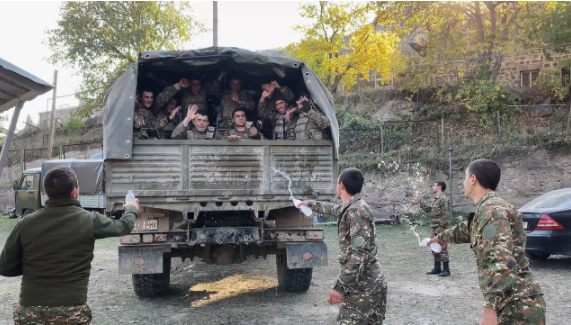Documenting the mundane, expecting the unpredictable
in International Documentary Film Festival Amsterdam (IDFA)
by Irina Trocan
The unexamined life is not worth living, and even less so in the age when we all carry a camera in our pockets. Many filmmakers seem to share the belief that their work is a personally transformative process – that thinking their experiences audiovisually alters their understanding of the world, and this interrelation between film and life should be especially true in the case of documentaries. At IDFA, Shoghakat Vardanyan’s 1489 (2023), was one of several highly personal films by emerging filmmakers, who decided to make their presence felt around the camera, often in diverging ways.

According to the broadest definition, 1489 would be a war film: the filmmaker started recording her family home while, seemingly far away, the Azeri-Armenian armed conflict was going on. Her younger brother, Soghomon, was recruited at the beginning of the war, leaving Shoghakat and her parents to eagerly wait for even the faintest news. The film grows steadily, in almost absolute chronological order, relying on the audience to pick up echoes of how the family perceives the war – to feel the growing suspense and anxiety – and with almost no inclusion of ‘solid facts’ to which violent incidents are reduced by the media. When the war ends, we piece together the news bulletin from a conversation between Shoghakat and her family – she wakes them up at night, seemingly unsure of the political outcome, letting spectators in on what they conclude this must mean for Armenians, and for them in particular. In another scene, a map of the battle is very roughly sketched out on a piece of paper when Soghomon’s father tries to understand where he might be.
The opening credits inform us that the film was shot over two years, which implies that, at a cursive 86-minute runtime, it is severely edited, and yet there is the impression of unhurried daily observation. We build a sense of place – the family home is undergoing renovation (which might explain why the parents sleep on a mattress on the floor), and the walls have a quasi-monastic unvarnished texture. There is one scene bordering on the satiric, in which Shoghakat phones for the military report on missing or dead soldiers to see if she can find out anything about her brother, which only results in an irritating lack of communication – as it turns out, even precious news of soldiers’ good health must pass through two bureaucratic call centers.
As it becomes evident in the documentary, it doesn’t simplify matters and, in a way, it only aggravates them, that the Nagorno-Karabakh war of 2020 only lasted forty-four days. Every day in which Soghomon doesn’t return home makes a grim possibility even more likely, and 1489 is committed to let us observe the family’s pain as it unfolds.
It must be said, knowing the difference between home movies and films in the IDFA International Competition, the fact that we were watching the film in Amsterdam was quite a bit of a spoiler – but the last part of the documentary more than makes up for the diminishing suspense through other means. After she started filming with hope to see her brother return, now Shoghakat must keep a steady hand while hearing the most devastating confirmation of her fears, and in this sense the willingness to share these moments with strangers amounts to a considerable act of bravery.
At this point, we’ve spent ample time with the family, to intuit the reactions behind the camera even with no trace of the filmmaker’s presence on the screen. The do-it-yourself nature of the film starts out as a minor visual shock – at IDFA, most documentaries have the look of a mid-budget arthouse film – and ends up as its best attribute. Who else, if not somebody inside this mourning family, can guide us through all the complexities and momentary, poignant feelings of grieving for a loved one?
Irina Trocan
© FIPRESCI 2023
Edited by Pamela Jahn
